How does ChemSAR benefit maritime safety in the Baltic Sea Region?

The activities of the ChemSAR Project ended in April and it is time to review the outcome. During the past three years, ChemSAR partners developed common guidelines and procedures to enhance the preparedness for HNS emergencies at sea and to make the rescue operations safer. They produced eLearning material to increase the capacities of maritime rescue authorities and services, and created the Chemical Dataportal to support rescue operations in finding reliable and comprehensive information on HNS. With these solutions, ChemSAR has significantly contributed to maritime safety in the area.

Lack of common operational plans and procedures
The ChemSAR project started as a response to the discovered lack of common operational plans and standard operational procedures (SOP) for search and rescue (SAR) operations applicable to hazardous and noxious substances (HNS) incidents in the Baltic Sea Region. As enormous quantities of different chemicals are all the time transported by sea, the risk of a major incident is evident and this challenge needed to be tackled. Also the existing practices and resources for operations in the region differ greatly.
Safer rescue operations with common procedures

ChemSAR partners jointly created the SOPs and operational plans, which will increase the safety of rescue operations in HNS incidents, both for the rescuees and rescue crews. Before going public, the SOPs were tested in tabletop and simulator exercises and then piloted in the ChemSAR live rescue exercise executed in September 2018 on Estonian waters.
The SOPs, OP and Checklists were published as Handbook for Maritime SAR in HNS Incidents, which can be downloaded at https://blogit.utu.fi/chemsar/material/.
ChemSAR eLearning materials and Chemical Dataportal
ChemSAR partners created an eLearning platform and materials to enable access to same kind of information related to rescue operations for the whole region. This enhances preparedness and rescue operations. The material offers an opportunity to harmonise the level of know-how related to maritime HNS incidents in the region, which is highly relevant in joint transnational rescue exercises and operations. In addition, ChemSAR partners have produced a Chemical dataportal. It is an easy-access tool to find reliable and comprehensive information on HNS in rescue operations. The eLearning environment and materials can be found at https://chemsar.utu.fi/ and the Chemical Dataportal at https://www.chemsarportal.com/.
Next steps
Rescue authorities from several countries have expressed that ChemSAR outcome, especially the developed standard operational procedure, fill in a gap related to maritime HNS incidents in the current existing procedures. ChemSAR has done the ground work and now it is time for the Baltic Sea Region maritime and rescue authorities and services to assimilate the developed best-practices in their national guidelines.
ChemSAR is a flagship project under the EUSBSR Policy Area Safe. Its best-practices continue being communicated and disseminated within the ResQU2 Project Platform together with three emergency handling related projects: DiveSMART Baltic, HAZARD and MIRG-EX.

Finally, to answer the question posed in the beginning, the Baltic Sea Region has gained better preparedness for emergencies at sea, and, more maritime safety due to ChemSAR.

Leave a Reply